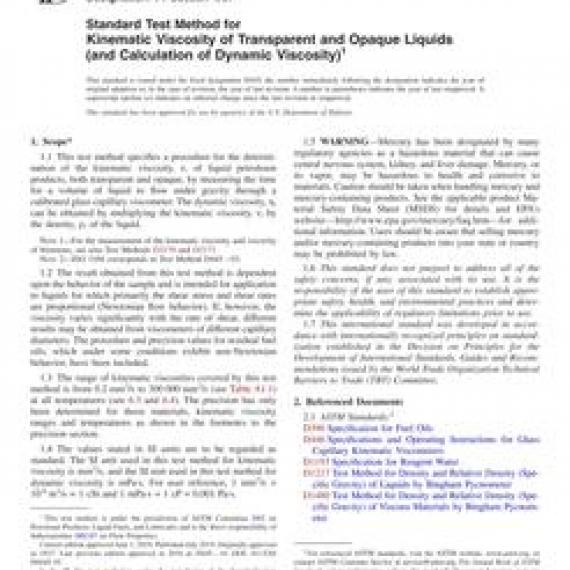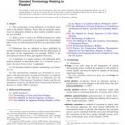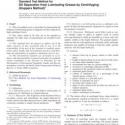No products
ASTM D445-19
ASTM D445-19 Standard Test Method for Kinematic Viscosity of Transparent and Opaque Liquids (and Calculation of Dynamic Viscosity)
standard by ASTM International, 06/01/2019
Full Description
1.1This test method specifies a procedure for the determination of the kinematic viscosity, , of liquid petroleum products, both transparent and opaque, by measuring the time for a volume of liquid to flow under gravity through a calibrated glass capillary viscometer. The dynamic viscosity, , can be obtained by multiplying the kinematic viscosity, , by the density, , of the liquid.
Note 1:For the measurement of the kinematic viscosity and viscosity of bitumens, see also Test Methods D2170 and D2171.
Note 2:ISO 3104 corresponds to Test Method D445-03.
1.2The result obtained from this test method is dependent upon the behavior of the sample and is intended for application to liquids for which primarily the shear stress and shear rates are proportional (Newtonian flow behavior). If, however, the viscosity varies significantly with the rate of shear, different results may be obtained from viscometers of different capillary diameters. The procedure and precision values for residual fuel oils, which under some conditions exhibit non-Newtonian behavior, have been included.
1.3The range of kinematic viscosities covered by this test method is from 0.2mm/s to 300000mm/s (see Table A1.1) at all temperatures (see 6.3 and 6.4). The precision has only been determined for those materials, kinematic viscosity ranges and temperatures as shown in the footnotes to the precision section.
1.4The values stated in SI units are to be regarded as standard. The SI unit used in this test method for kinematic viscosity is mm/s, and the SI unit used in this test method for dynamic viscosity is mPas. For user reference, 1 mm/s = 10-6m/s = 1 cSt and 1 mPas = 1 cP = 0.001 Pas.
1.5WARNING-Mercury has been designated by many regulatory agencies as a hazardous material that can cause central nervous system, kidney, and liver damage. Mercury, or its vapor, may be hazardous to health and corrosive to materials. Caution should be taken when handling mercury and mercury-containing products. See the applicable product Material Safety Data Sheet (MSDS) for details and EPAs website-http://www.epa.gov/mercury/faq.htm-for additional information. Users should be aware that selling mercury and/or mercury-containing products into your state or country may be prohibited by law.
1.6This standard does not purport to address all of the safety concerns, if any, associated with its use. It is the responsibility of the user of this standard to establish appropriate safety, health, and environmental practices and determine the applicability of regulatory limitations prior to use.
1.7This international standard was developed in accordance with internationally recognized principles on standardization established in the Decision on Principles for the Development of International Standards, Guides and Recommendations issued by the World Trade Organization Technical Barriers to Trade (TBT) Committee.


































